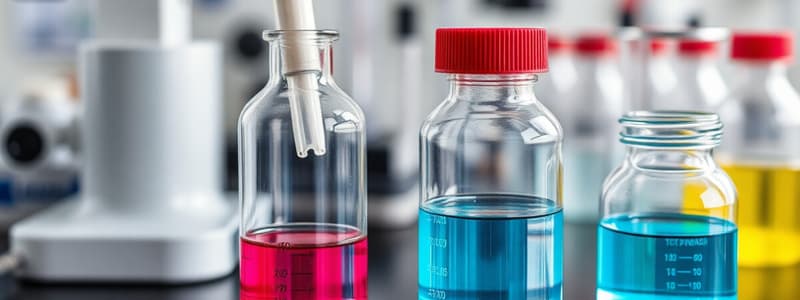Podcast
Questions and Answers
What is the primary purpose of chromatography?
What is the primary purpose of chromatography?
- To increase the solubility of a compound
- To separate and/or identify substances in a mixture (correct)
- To change the pH level of a solution
- To measure the temperature of substances
Which type of chromatography involves the use of a stationary phase and a mobile phase?
Which type of chromatography involves the use of a stationary phase and a mobile phase?
- Atomic spectroscopy
- Nuclear magnetic resonance
- Infrared spectroscopy
- Gas chromatography (GC) (correct)
Which instrument is used to measure UV and visible light absorption in a sample?
Which instrument is used to measure UV and visible light absorption in a sample?
- Gram scale
- pH meter
- UV-vis spectrophotometer (correct)
- Refractometer
What is required for a sample to absorb light in the UV-Vis region?
What is required for a sample to absorb light in the UV-Vis region?
What does a UV-vis spectrophotometer measure in terms of light?
What does a UV-vis spectrophotometer measure in terms of light?
Study Notes
Chromatography
- Chromatography is a technique used to separate and identify substances within a mixture.
- It has wide applications in industrial pharmacy.
- Common types of chromatography include Thin Layer Chromatography (TLC), High Performance Liquid Chromatography (HPLC), and Gas Chromatography (GC).
Spectroscopic Techniques
- Spectroscopic techniques utilize light to analyze substances.
- Some examples of these techniques include:
- Ultraviolet and Visible (UV-VIS) Spectroscopy
- Atomic Spectroscopy
- Infrared Spectroscopy
- Raman Spectroscopy
- Nuclear Magnetic Resonance
- Mass Spectroscopy
UV-Visible Spectroscopy
- A UV-vis spectrophotometer measures the amount of ultraviolet (UV) and visible light absorbed by a sample.
- It is a widely used technique for identifying and quantifying compounds across various fields.
- A sample must contain a chromophore to be analyzed in the UV-Vis region.
- The UV-Vis spectrophotometer operates by transmitting a light beam through the sample.
- The amount of light absorbed at each wavelength is measured and is proportional to the concentration of the absorbing compound in the sample.
- Creating calibration curves is essential for quantitative analysis.
Studying That Suits You
Use AI to generate personalized quizzes and flashcards to suit your learning preferences.
Related Documents
Description
This quiz covers the essential techniques of chromatography and various spectroscopic methods. You will explore the principles, applications, and types of chromatography, as well as the fundamental concepts behind spectroscopic analysis. Test your knowledge on UV-Visible spectroscopy and its relevance in different fields.




